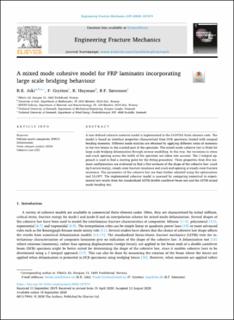A mixed mode cohesive model for FRP laminates incorporating large scale bridging behaviour
Peer reviewed, Journal article
Published version
Permanent lenke
https://hdl.handle.net/11250/2687840Utgivelsesdato
2020Metadata
Vis full innførselSamlinger
- Publikasjoner fra CRIStin - SINTEF AS [5802]
- SINTEF Industri [1566]
Sammendrag
A user defined cohesive material model is implemented in the LS-DYNA finite element code. The model is based on interface properties characterised from DCB specimens loaded with unequal bending moments. Different mode mixities are obtained by applying different ratios of moments to the two beams in the cracked part of the specimen. The mixed mode cohesive law is fitted for large scale bridging delamination through inverse modelling. In this way, the variations in stress and crack opening across the width of the specimen are taken into account. The J integral approach is used to find a starting point for the fitting procedure. Three properties from five moment configurations are evaluated to find a first estimate of the shape of the cohesive law: crack tip fracture energy, steady-state fracture resistance and crack end-opening at steady-state fracture resistance. The parameters of the cohesive law are then further adjusted using the optimisation tool LS-OPT. The implemented cohesive model is assessed by comparing numerical to experimental test results from the standardised ASTM double cantilever beam test and the ASTM mixed mode bending test.

